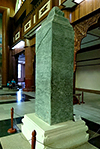|
Yaza Kumar (ရာဇကုမာရ်)
Burmese. Name of an
11-12th Century AD Prince of
Bagan,
i.e.
the son of
King
Kyansittha
(fig.)
and titular governor of north
Arakan, that is present-day Rakhine State.
He is best known for the 1112-1113 AD Yaza Kumar Stone Inscription,
named after him and which he dedicated to his father's honour. This
quadrangular, sandstone pillar has four faces, with on each side an inscription
of the same text in
four different languages, namely
Pyu,
Mon,
Pali,
and Burmese, i.e. the language of the
Bamar.
The stone inscription has scholarly significance because it has
allowed for the deciphering of the Pyu
language, in a way akin to how the Rosetta Stone Inscriptions
provided the key to the modern understanding of Egyptian
hieroglyphs. In addition, it is
an important source of Bagan history.
There are actually two identical
contemporary pillars, which are individually also referred to as the
Gu Byauk Gyi Zedi Myinkaba (fig.)
or
Gu Byauk Gyi
Inscription and the
Myazedi Phaya (map
-
fig.)
or
Mya
Zedi
Inscription (fig.). These names derive
from the temples near the places where the pillars were discovered
in 1886-1887 AD, in the early days of the British colonial rule, by
Dr. E. Forchammer, a German medical doctor and scholar, and the
first superintendent of the
Burma
Branch of the Epigraphic Office
of the Archaeological Survey of India. The pillar discovered near
Mya Zedi was first found broken in pieces, which were joined
and set up on a platform at Mya Zedi
Pagoda.
The Gu Byauk Gyi Inscription, an identical copy, is today on display
at the Bagan Archaeological Museum (map
-
fig.).
Prince Yaza Kumar's name may also be transcribed Yazakumar, Yaza Kuma or
Yaza
Kumara.
回






|

